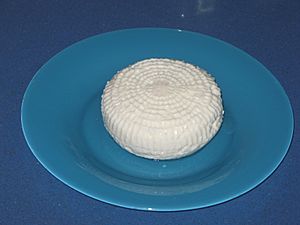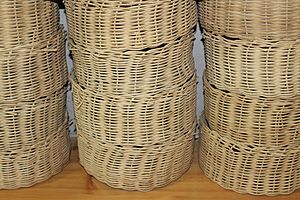Tzfat cheese facts for kids
Quick facts for kids Tzfat Cheese |
|
|---|---|
 |
|
| Country of origin | Israel |
| Region | Upper Galilee |
| Town | Safed |
| Source of milk | Cow, Sheep, Goat, Water Buffalo |
| Texture | Semi-hard fresh and hard aged |
| Aging time | 3 to 12 months |
| Named after | Lua error in Module:Wikidata at line 70: attempt to index field 'wikibase' (a nil value). |
Tzfat cheese (pronounced "Tz-fat") is a special kind of cheese from Israel. It's a bit salty and has a unique texture. This cheese was first made in a city called Safed (which is "Tzfat" in Hebrew) way back in 1840. Even today, the families of the original cheese makers are still making it there!
The Story of Tzfat Cheese
The first Tzfat cheese was made in 1818 at the HaMeiri Dairy. This dairy was started by Meir Arzoni, who later became known as HaMeiri. He had moved to Israel from Persia.
The cheese is shaped in a special basket. This basket gives the cheese its unique round shape and cool patterns on its surface.
How Tzfat Cheese is Made
Tzfat cheese has a stretchy feel and isn't very fatty. The milk used to make it is gently heated to about 72 degrees Celsius (161 degrees Fahrenheit). This low heat helps keep the good proteins in the milk.
Making the cheese involves special enzymes and calcium chloride. These ingredients help the milk curdle, which means it separates into solid curds and liquid whey. This process happens quite fast, in about an hour.
After the milk curdles, most of the liquid whey is drained away. The cheese curds are then placed in straw or plastic baskets. They stay there for several hours to drain even more whey and to get their famous round shape. The cheese is flipped over a few times while draining. This makes sure the basket pattern appears on all sides.
Enjoying Tzfat Cheese
Fresh Tzfat cheese is often used in salads or in sandwiches. It has a mild taste that goes well with many foods.
There's also an aged version of Tzfat cheese. This cheese is older and harder. You can grate it, just like Parmesan, and use it in baking or cooking.
Sometimes, Tzfat cheese made from water buffalo milk is flavored with tiny black seeds called nigella seeds. These seeds add a unique and delicious taste to the cheese.


